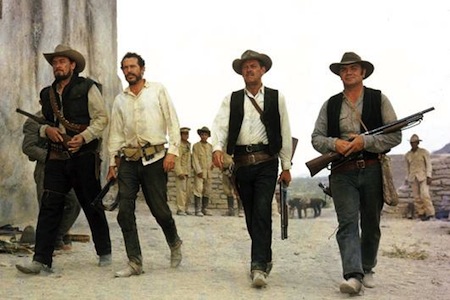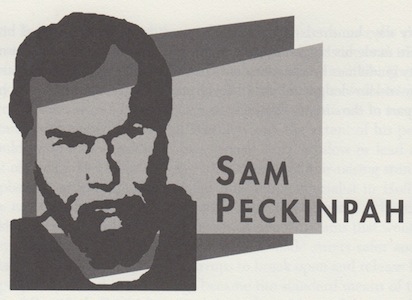
Born: February 21, 1925, Fresno, CA
Died: December 28, 1984, Inglewood, CA
Violence, with Peckinpah, sometimes becomes a psychic ballet.
—Roger Ebert
Sam Peckinpah spent his formative years as an assistant to Don Siegel, the director who would later originate the Dirty Harry franchise starring Clint Eastwood. Both Eastwood and Peckinpah would become forever connected to screen violence in the western, but while Eastwood simply refined the style of the genre, Peckinpah explored its soul.
Peckinpah was first placed in the saddle writing and directing episodes of western series, including Gunsmoke and The Rifleman, in the early days of television. A 1957 rough outline of a script for One-Eyed Jacks (1961) led to a bizarre portrayal of Billy the Kid by method actor Marlon Brando, and a directing exercise titled The Losers, on TV’s Dick Powell Theater in 1963, employed startling slow-motion gun battles, a celebrated effect that Peckinpah would use to excess in later films.
His introduction to Hollywood moviemaking was rocky; he battled with studio executives over the production of his first feature, Major Dundee (1965) and was virtually blacklisted for being too difficult. However, his brutal and disturbing Straw Dogs (1971) raised the controversial Peckinpah into the echelon of Arthur Penn, Francis Ford Coppola and other directors who were putting a personal stamp on films inside long-established genres. These artists were referred to as the purveyors of the American New Wave, the result of French film influences on Hollywood.
Next, a trilogy of stylistic, elegiac horse dramas addressed the mythological masculinity of cowboys, a theme that would flow through the rest of Peckinpah’s work, starting with the release of The Wild Bunch (1969). Wild Bunch did have important impact; first, it stripped away all of the heroic values that John Ford had created in his years of making outstanding westerns with John Wayne. Unlike the majestic pillars of the Monument Valley settings in Ford’s films, Peckinpah’s locations were bleak and unvarnished, and the violence was gratuitous and realistic. Also, the actions of cowboy stars in Peckinpah stories were predicated on the thematic message, not a personal code. The unspoken rules of the macho cowboy no longer applied. There was no moral clarity in the films. The extended and unjustified violent outbursts of gunslingers became a metaphor for misguided attempts to resolve situations that had no distinct right and wrong sides.
By the time Peckinpah’s next films, Junior Bonner (1972) and Pat Garrett and Billy the Kid (1973), had finished their runs, some critics had convicted him of killing off the western. On the other hand, he has been credited with turning the genre from moral simplicity to moral complexity. His elegiac tones and lyrical execution make it almost impossible to watch typical action westerns with the childlike excitement they once invoked. Ironically, it would be twenty-five years before Clint Eastwood’s Unforgiven (1992) would restore order to the western, tipping its hat to both the beauty of Ford’s calm and the conscience of Peckinpah’s chaos.
Peckinpah’s greatest influence on film was through his handling of violence. The masterful slow-motion scenes in Wild Bunch reverberated throughout the films of the 1970s. The technique became synonymous with its director. It was imitated in shootouts in cop dramas and gangster films, and spoofed in comedies. Recently, the work of Robert Rodriguez in El Mariachi (1992) and Desperado (1995) has mocked the slow-motion style by bringing it to a crawl.
Though the term “cathartic” had been applied to the violent nature of his earlier work, Peckinpah was later blamed for simply glorifying violence in The Getaway (1972) and Bring Me the Head of Alfredo Garcia (1974), and the ensuing increase in tasteless and irresponsibly violent films is often attributed directly to him.
Still, Peckinpah sparked a debate about violence in films that surfaces perennially—it seems every year brings a real life crime that its perpetrators claim was inspired by a movie. Few directors have affected the way in which action scenes are choreographed and recorded. In an effort to emulate the stylized sequences that Peckinpah repeatedly produced, a slew of talented filmmakers, from Martin Scorsese to Quentin Tarantino, have added even more bullet holes and blood to their climactic shootouts. Few, however, ever achieve the elegiac quality that Peckinpah infused, even during his most chaotic screen moments.
To read all the republished articles from ‘The Film 100,’ go to Reintroducing the Film 100 here on Keyframe.




